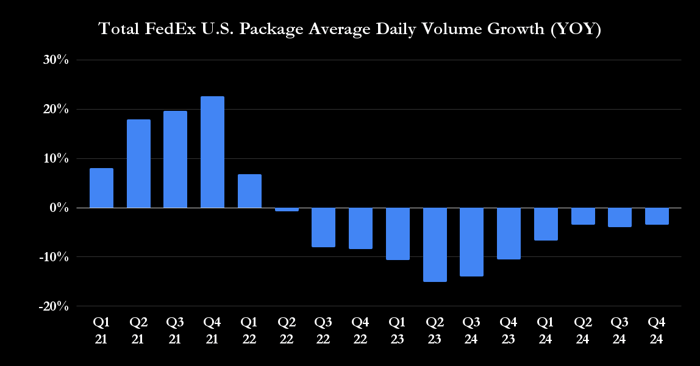A solid earnings report from FedEx (FDX 2.29%) sent its shares soaring, and that's probably why UPS (UPS 1.76%) stock rose in the first trading day after the earnings release. Such events are common in investing, and a deeper look at the earnings reports suggests some positive takeaways for UPS investors. Here are five of them for UPS investors to consider.
FedEx domestic volumes are improving
A key part of UPS' investment case is the idea that its volumes, particularly U.S. domestic volumes, will start growing again in the second half of the year -- UPS' financial year coincides with the calendar year, and FedEx's finishes at the end of May.
UPS management believes its second-quarter U.S. domestic average daily volume growth will be slightly positive year over year in the second quarter to the end of June. It remains to be seen whether UPS will report this, but the fact that the volume decline in the U.S. is moderating at FedEx is a positive indication.

Data source: FedEx presentations. Chart by author.
Volume guidance is good
Digging into management's commentary on the earnings call, FedEx is predicting low to mid-single-digit revenue growth overall in 2025, with Chief Customer Officer Brie Carere noting the revenue growth will be "largely volume-driven, and will be driven from a deferred and an e-commerce perspective.
As such, FedEx and UPS are seeing an improving volume environment, and that's a plus for UPS' growth plans.
Yields remain in positive territory
One key point of UPS' three-year plan is that its revenue per piece will rise more than its cost per piece. For that to happen, UPS needs a good pricing environment. The good news is that FedEx's CFO, John Dietrich, is "anticipating a pricing environment that is competitive but rational.
Moreover, FedEx's revenue per package continues to grow, with U.S. revenue per package improving 2.2% year over year to $23.14 in the fourth quarter. Similarly, the total composite package yield rose 2.1% year over year to
Again, that's a positive for UPS' pricing strategy.

Image source: Getty Images.
E-commerce growth is back
The lockdown measures have somewhat distorted the dynamics of e-commerce growth in recent years. The stay-at-home measures accelerated growth in e-commerce spending, only for it to slow due to a natural correction after torrid growth rates during the lockdowns.
The excellent news is FedEx's management believes that e-commerce growth will be a "primary factor" in hitting its revenue growth target in its fiscal-year 2025.
Carere thinks e-commerce delivery growth will outpace business-to-business (B2B) demand. A pick-up in e-commerce is good news because it implies consumer spending trends are returning to pre-pandemic conditions.

Image source: Getty Images.
Healthcare expansion
Another bullish sign for UPS is FedEx's expansion of its healthcare capability to take advantage of higher-value activities. Such actions vindicate UPS' strategy of aggressively growing its higher-margin healthcare-related revenue. For example, on its recent investor day in late March, UPS management outlined how it almost doubled its healthcare-related revenue from $5.1 billion in 2016 to $10 billion in 2023 and planned to double it to $20 billion by 2026.
The takeaway for UPS investors
FedEx management is discussing a "modest improvement" in demand in its financial 2025. While that may appear less optimistic than UPS calling for a low-single-digit year-over-year increase in its domestic volume in the second half, there are other factors to consider.
For example, UPS has a growth opportunity coming from winning back lost customers who diverted volumes to other networks, including FedEx, in fear of strike action during last year's labor contract negotiations.

Image source: Getty Images.
If UPS achieves volume improvement in the second half and revenue-per-package growth is in line with FedEx's expectations for the market, then UPS can achieve revenue growth in the 4% to 8% range it expects in the second half of 2024.
Meanwhile, ongoing growth in UPS' target markets (including healthcare and e-commerce deliveries) will help revenue growth and margin expansion. All told, while FedEx's earnings weren't great, they were enough to dispel the worst fears over demand deterioration, and that signals that UPS could be on track to hit its full-year guidance. Given that Wall Street expects UPS to generate $8.19 in earnings per share in 2024 and $9.71 in 2025, the stock trades at slightly more than 14 times estimated 2025 earnings, an excellent valuation.




